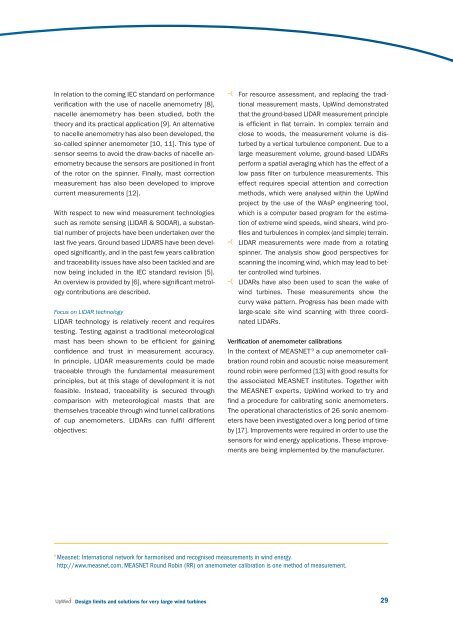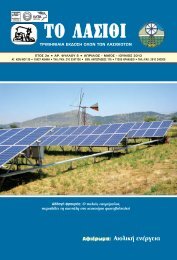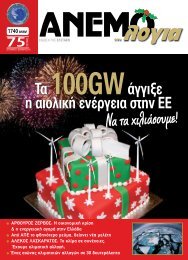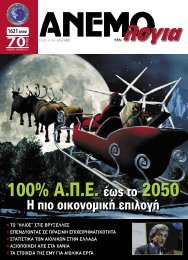Design limits and solutions for very large wind turbines
Design limits and solutions for very large wind turbines
Design limits and solutions for very large wind turbines
You also want an ePaper? Increase the reach of your titles
YUMPU automatically turns print PDFs into web optimized ePapers that Google loves.
In relation to the coming IEC st<strong>and</strong>ard on per<strong>for</strong>mance<br />
verifi cation with the use of nacelle anemometry [8],<br />
nacelle anemometry has been studied, both the<br />
theory <strong>and</strong> its practical application [9]. An alternative<br />
to nacelle anemometry has also been developed, the<br />
so-called spinner anemometer [10, 11]. This type of<br />
sensor seems to avoid the draw-backs of nacelle anemometry<br />
because the sensors are positioned in front<br />
of the rotor on the spinner. Finally, mast correction<br />
measurement has also been developed to improve<br />
current measurements [12].<br />
With respect to new <strong>wind</strong> measurement technologies<br />
such as remote sensing (LIDAR & SODAR), a substantial<br />
number of projects have been undertaken over the<br />
last fi ve years. Ground based LIDARS have been developed<br />
signifi cantly, <strong>and</strong> in the past few years calibration<br />
<strong>and</strong> traceability issues have also been tackled <strong>and</strong> are<br />
now being included in the IEC st<strong>and</strong>ard revision [5].<br />
An overview is provided by [6], where signifi cant metrology<br />
contributions are described.<br />
Focus on LIDAR technology<br />
LIDAR technology is relatively recent <strong>and</strong> requires<br />
testing. Testing against a traditional meteorological<br />
mast has been shown to be effi cient <strong>for</strong> gaining<br />
confi dence <strong>and</strong> trust in measurement accuracy.<br />
In principle, LIDAR measurements could be made<br />
traceable through the fundamental measurement<br />
principles, but at this stage of development it is not<br />
feasible. Instead, traceability is secured through<br />
comparison with meteorological masts that are<br />
themselves traceable through <strong>wind</strong> tunnel calibrations<br />
of cup anemometers. LIDARs can fulfil different<br />
objectives:<br />
For resource assessment, <strong>and</strong> replacing the traditional<br />
measurement masts, UpWind demonstrated<br />
that the ground-based LIDAR measurement principle<br />
is effi cient in fl at terrain. In complex terrain <strong>and</strong><br />
close to woods, the measurement volume is disturbed<br />
by a vertical turbulence component. Due to a<br />
<strong>large</strong> measurement volume, ground-based LIDARs<br />
per<strong>for</strong>m a spatial averaging which has the effect of a<br />
low pass filter on turbulence measurements. This<br />
effect requires special attention <strong>and</strong> correction<br />
methods, which were analysed within the UpWind<br />
project by the use of the WAsP engineering tool,<br />
which is a computer based program <strong>for</strong> the estimation<br />
of extreme <strong>wind</strong> speeds, <strong>wind</strong> shears, <strong>wind</strong> profiles<br />
<strong>and</strong> turbulences in complex (<strong>and</strong> simple) terrain.<br />
LIDAR measurements were made from a rotating<br />
spinner. The analysis show good perspectives <strong>for</strong><br />
scanning the incoming <strong>wind</strong>, which may lead to better<br />
controlled <strong>wind</strong> <strong>turbines</strong>.<br />
LIDARs have also been used to scan the wake of<br />
<strong>wind</strong> <strong>turbines</strong>. These measurements show the<br />
curvy wake pattern. Progress has been made with<br />
<strong>large</strong>-scale site <strong>wind</strong> scanning with three coordinated<br />
LIDARs.<br />
Verification of anemometer calibrations<br />
In the context of MEASNET 9 a cup anemometer calibration<br />
round robin <strong>and</strong> acoustic noise measurement<br />
round robin were per<strong>for</strong>med [13] with good results <strong>for</strong><br />
the associated MEASNET institutes. Together with<br />
the MEASNET experts, UpWind worked to try <strong>and</strong><br />
find a procedure <strong>for</strong> calibrating sonic anemometers.<br />
The operational characteristics of 26 sonic anemometers<br />
have been investigated over a long period of time<br />
by [17]. Improvements were required in order to use the<br />
sensors <strong>for</strong> <strong>wind</strong> energy applications. These improvements<br />
are being implemented by the manufacturer.<br />
9<br />
Measnet: International network <strong>for</strong> harmonised <strong>and</strong> recognised measurements in <strong>wind</strong> energy.<br />
http://www.measnet.com, MEASNET Round Robin (RR) on anemometer calibration is one method of measurement.<br />
<strong>Design</strong> <strong>limits</strong> <strong>and</strong> <strong>solutions</strong> <strong>for</strong> <strong>very</strong> <strong>large</strong> <strong>wind</strong> <strong>turbines</strong><br />
29









